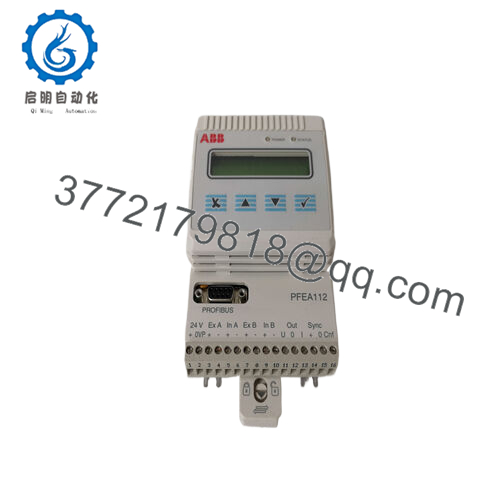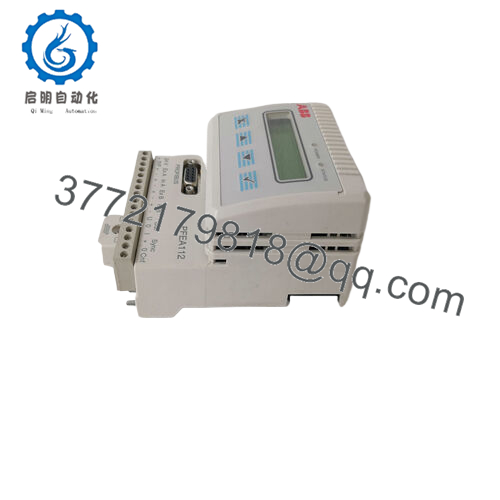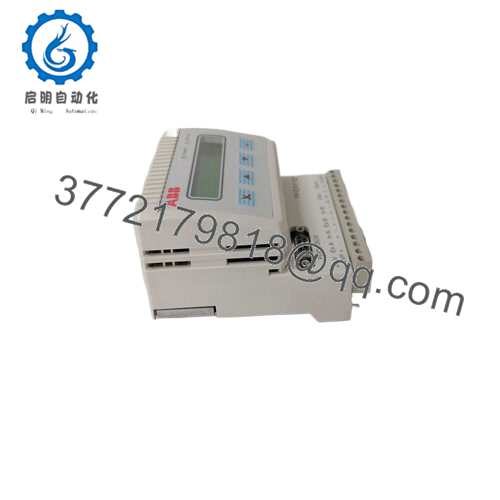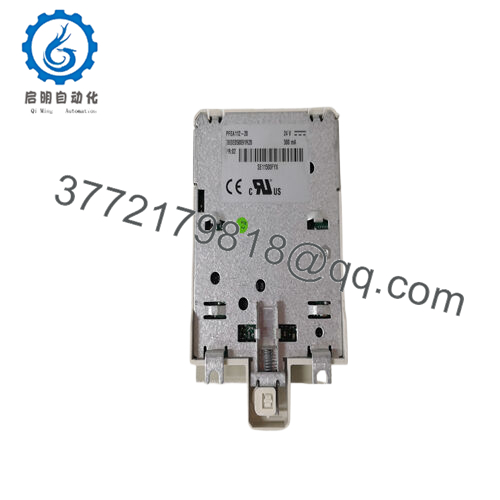Description
Precision in web handling processes often hinges on maintaining optimal material tension—too slack, and you get wrinkles or misalignment; too tight, and risks like tearing or uneven winding disrupt the entire line. For engineers in industrial automation, this translates to constant battles against variability from speed changes, roll diameters, or substrate inconsistencies, especially in high-throughput environments where even minor drifts amplify waste and downtime. Enter the ABB PFEA112-20, a versatile tension electronics module from ABB’s PFEA series, crafted to deliver accurate, real-time tension control that stabilizes these dynamics without overcomplicating your setup.
This module shines in scenarios where process control demands reliable I/O signal conditioning for load cells, such as converting raw force data into actionable voltage or current outputs for drive systems. Imagine a paper mill’s slitter-rewinder, where fluctuating web speeds challenge operator interventions, or a flexible packaging line feeding into converters at 1,000 m/min—here, the ABB PFEA112-20 becomes essential by processing dual load cell inputs to compute sum or difference tensions, enabling closed-loop adjustments that keep quality consistent. It sidesteps common pitfalls like signal noise from vibrations or electromagnetic interference, ensuring high reliability in modular I/O architectures where integration with PLCs or DCS is non-negotiable.
- PFEA112-20
What elevates its role in industrial automation is the focus on adaptability: adjustable filtering lets you tune response times to match your web’s characteristics, from delicate films to robust foils, all while supporting fieldbus protocols for seamless data sharing. For teams evaluating upgrades, the ABB PFEA112-20 isn’t merely a signal conditioner—it’s a proactive stabilizer that minimizes scrap rates and boosts throughput, addressing the hidden costs of imprecise control in an era of lean operations. By embedding intelligence at the sensor level, it empowers engineers to achieve system stability across diverse substrates, turning potential bottlenecks into streamlined efficiencies that align with sustainability goals like reduced material loss.
How the Product Works & Fits into a System
Fundamentally, the ABB PFEA112-20 acts as an intelligent interface for web tension measurement, taking inputs from two load cells—typically mounted on idler rolls or bridles—and transforming them into calibrated outputs that drive tension actuators like pneumatic brakes or servo motors. It calculates tension metrics in real time, such as total force (sum mode) for symmetric setups or differential pull (difference mode) for dancer arm controls, applying user-configurable filters to smooth out transients without introducing lag. Powered by a compact microcontroller, it outputs via isolated voltage (0-10 V) or current (4-20 mA) loops, scalable to match your system’s needs, and displays status through intuitive LED indicators or optional front-panel readout.
In the broader automation stack, this module nests comfortably in the field I/O layer, DIN-rail mounted alongside S800 series modules or integrated into ABB’s 800xA DCS for overarching process control. It connects via screw terminals for load cells (supporting 2-wire or 4-wire configurations) and analog outputs, while RS-485 or Modbus RTU enables polling from upstream controllers like AC 800M PLCs—think of it handing off tension setpoints and alarms to a central HMI for operator oversight. Diagnostics are embedded, with self-tests for sensor integrity and over/under-range alerts that feed into system-wide event logs, reducing mean time to resolution in fault scenarios.
Its modularity extends to redundancy-friendly designs: in multi-zone lines, multiple ABB PFEA112-20 units can cascade over bus networks, synchronizing data for profile control across unwinds and rewinds. For legacy integrations, it bridges older analog sensors with modern Ethernet/IP overlays, minimizing rewiring. This positioning—close to the physics of the web—offloads computational load from the PLC, allowing faster loop closures (often under 100 ms) that enhance stability in variable-speed drives. In essence, the ABB PFEA112-20 weaves into your architecture like a precision thread, fostering cohesive control that adapts to the web’s flow rather than fighting it, all while keeping the engineering footprint light.
| Specification | Details |
|---|---|
| Model Number | PFEA112-20 (3BSE050091R20) |
| Brand | ABB |
| Type | Tension Electronics Module |
| Input Voltage | 24 V DC (18-30 V) |
| Operating Temp Range | -20°C to +60°C |
| Mounting Style | DIN Rail |
| Dimensions | 22.5 x 115 x 120 mm (W x H x D) |
| Weight | 0.5 kg |
| Interface/Bus | Screw Terminals, RS-485 |
| Compliance | CE, RoHS, IP20 |
| Supported Protocols | Modbus RTU |
| Typical Power Draw | 5 W (500 mA @ 24 V DC) |
Real-World Benefits
Opting for the ABB PFEA112-20 equips your line with a level of tension precision that directly curbs defects, engineered to filter out the noise of real-world variables like roll bounce or humidity shifts, ensuring outputs remain true to the web’s actual behavior. This translates to fewer breaks and splices in high-speed operations, where even a 5% tension variance can spike waste by 10%—in practice, users see measurable drops in material scrap, often recouping costs within months through sustained yield improvements. The module’s isolated channels prevent ground loops from propagating faults, safeguarding sensitive drives and extending the lifespan of downstream components in dusty or electrically noisy plants.
Ease of tuning stands out too, with front-accessible pots for gain and zero adjustments that let technicians dial in performance on the fly, slashing commissioning times and reducing the engineering overhead tied to custom software tweaks. Over extended runs, its robust construction—vibration-dampened internals and conformal-coated boards—delivers consistent I/O signal integrity, minimizing calibration drifts that plague lesser units and ensuring long-term performance aligned with ISO standards for process repeatability. One converter noted a 15% throughput gain post-install, attributing it to the module’s quick-response filtering that kept tension profiles flat across substrate changes.
The ripple effect hits operations hard: operators gain confidence from clear fault LEDs and stable displays, cutting intervention frequency and enabling shift teams to focus on optimization rather than firefighting. By streamlining data flow to SCADA, it unlocks predictive insights—like early warnings on roll inconsistencies—fostering proactive maintenance that averts unscheduled stops. For engineers balancing budgets and reliability, the ABB PFEA112-20 proves its worth not in specs alone, but in the operational fluidity it unlocks, turning tension control from a reactive chore into a seamless enabler of efficiency and quality.
Typical Use Cases
In the paper and pulp sector, the ABB PFEA112-20 underpins calender stack controls, where it processes load cell data from chilled rolls to maintain uniform nip pressures during high-speed sheeting, countering thermal expansions that could otherwise cause gauge bands. Its adjustable filtering excels in these continuous uptime environments, delivering high-reliability tension signals amid steam and fiber dust, integral to process control that meets pulp mill throughput targets without compromising sheet flatness.
Flexible packaging lines deploy the ABB PFEA112-20 for lamination towers, computing differential tensions across idlers to synchronize multiple webs of foil and film, preventing bubbles or delamination in real-time cycles exceeding 800 m/min. Harsh conditions like solvent vapors test its seals, but the IP20-rated design and wide temp tolerance ensure critical system uptime, making it a fixture in converters chasing defect-free rolls for food-grade applications.
Within metal processing, such as aluminum foil rolling mills, the module drives bridle zone actuators by conditioning signals from dancer pots, adapting to gauge variations for precise edge control. Fast data cycles—under 50 ms—support the demands of cold rolling, where the ABB PFEA112-20 integrates into PLC loops for automated profiling, bolstering efficiency in environments prioritizing minimal downtime and surface quality. Across these industries—paper, packaging, and metals—the ABB PFEA112-20 handles the rigors of web-based automation, proving vital for stability in dynamic, high-volume production.
Compatible or Alternative Products
PFEA111-20 3BSE050090R20 – Single load cell variant for simpler unwind/rewind zones in entry-level tension setups.
PFEA113-20 3BSE028144R0020 – Advanced model with display and setpoint inputs for standalone operator adjustments.
PFEA112-65 3BSE050092R20 – Higher current output (65 mA) for longer cable runs in distributed web lines.
PFEA111-65 3BSE028140R0065 – Compact single-input unit with extended range for heavy-duty substrates like textiles.
PFEA113-65 3BSE028144R0065 – Multi-function electronics with relay outputs for alarm integration in safety loops.
PFTL101A 2KN – Compatible load cell for light-duty tension measurement, pairing with PFEA modules for full kits.
TTC-1 3BSE030369R0020 – Tension transducer controller add-on for enhanced filtering in noisy environments.
Setup Notes & Maintenance Insights
Before powering up the ABB PFEA112-20, map out your load cell wiring—verify 4-20 mA excitation matches the cells’ specs to avoid offset errors right out of the gate, and use shielded cable for runs over 50 meters to combat induced noise in motor-heavy areas. DIN rail placement should prioritize ventilation; ambient temps pushing 50°C call for forced air if enclosed, as the module’s heat sink relies on convection for steady operation. Firmware isn’t field-updatable here, but confirm the dip switches align with your output mode (voltage vs. current) per the wiring diagram—misconfigs lead to inverted signals that confuse drive tuning.
Maintenance routines keep it reliable with straightforward checks that fit into quarterly walks. Start with visual scans: look for corrosion on terminals, especially in humid mills, and re-torque connections to 0.6 Nm to fend off vibration creep. Every three months, simulate inputs with a calibrator to validate zero and span—drift beyond 1% flags a cell issue, not the module, saving needless swaps. The status LEDs offer quick health reads: steady green means balanced inputs, while flashing patterns pinpoint open circuits, letting you log trends in a maintenance app for pattern spotting. Annually, disconnect power and clean dust from the PCB with low-pressure air, steering clear of solvents that could degrade the conformal coat. In web environments prone to lint buildup, a mesh filter over vents extends MTBF, but monitor for restricted flow. These targeted practices, honed from line deployments, ensure the ABB PFEA112-20 remains a set-it-and-forget-it asset, letting your focus shift to process tweaks over hardware worries.





 WhatsApp: +86 16626708626
WhatsApp: +86 16626708626 Email:
Email:  Phone: +86 16626708626
Phone: +86 16626708626


